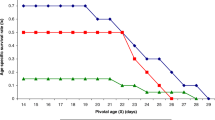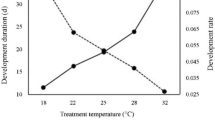Abstract
In this study, the effect of host density, host, and parasitoid ages in choice and no-choice tests on the parasitism performance of Tetrastichus brontispae Ferriere, one of the major parasitoid of Brontispa longissima (Gestro), was investigated in the laboratory. The results revealed that an increased host density resulted in no increased parasitism of B. longissima by T. brontispae; the optimal host density was three host pupae per parasitoid when considering the costs for mass rearing. Moreover, parasitoid age was quite crucial for effective parasitism and affected the emergence rate. Although 2-h to 4-day-old parasitoids successfully parasitized the host pupae, younger parasitoids (within 2-day-old) presented higher parasitism capacity than older parasitoids. More importantly, both choice and no-choice tests confirmed that all host stages tested from 2-h to 4-day-old were suitable for T. brontispae parasitization, although 2-h to 2-day-old hosts were preferred. We also demonstrated that sex ratio, emergence rate, and egg to adult developmental time were not influenced by host density, parasitoid, and host age in both choice and no-choice tests. Our data will allow for more accurate prediction and interpretation on the parasitization by T. brontispae, supporting mass-production initiatives and mass release in programs of B. longissima.


Similar content being viewed by others
References
Amalin DM, Pena JE, Duncan RE (2005) Effects of host age, female parasitoid age, and host plant on parasitism of Ceratogramma etiennei (Hymenoptera: Trichogrammatidae). Fla Entomol 88:77–82
Aung KSD, Takagi M, Ueno T (2010) Effect of female’s age on the progeny production and sex ratio of Ooencyrtus nezarae, an egg parasitoid of the bean bug Riptortus clavatus. J Fac Agr Kyushu U 55:83–85
Ayvaz A, Karasa E, Karaborklu S, Tuncbilek A (2008) Effects of cold storage, rearing temperature, parasitoid age and irradiation on the performance of Trichogramma evanescens Westwood (Hymenoptera: Trichogrammatidae). J Stored Prod Res 44:232–240
Barratt BIP (2004) Microctonus parasitoids and New Zealand weevils: comparing laboratory estimates of host ranges to realized host ranges. In: Van Driesche RG, Reardon R (eds) Assessing host ranges for parasitoids and predators used for classical biological control: a guide to best practice. FHTET-2004-03, Morgantown, pp 103–120
Chen Q, Peng Z, Xu C, Lu B, Jin Q, Wen H, Wan F (2010) Biological assessment of Tetrastichus brontispae, a pupal parasitoid of coconut leaf beetle, Brontispa longissima. Biocontrol Sci Techn 20:283–295
Chiu SC, Chien BH (1985) Importation and establishment of Tetrastichus brontispae, a parasitoid of the coconut leaf beetle, in Taiwan. Taiwan Agr Res Ins 19:12–13
Duan JJ, Messing RH (1999) Evaluating nontarget effects of classical biological control: fruit fly parasitoids in Hawaii as a case study. In: Follett PA, Duan JJ (eds) Nontarget effects of biological control. Kluwer Academic Publishers, Dordrecht, pp 95–110
Edwards PB (1999) The use of choice tests in host-specificity testing of herbivorous insects. In: Withers TM, Barton BL, Stanley J (eds) Host specificity testing in Australasia: towards improved assays for biological control. Scientific Publishing, Department of Natural Resources, Brisbane, pp 35–43
Godfray HCJ (1994) Parasitoids: behavioural and evolutionary ecology, princeton. Princeton University Press, NJ, p 484
Goldson SL, Phillips CB (1990) Biological control in pasture and lucerne and the requirements for further responsible introduction of entomophagous insects. B Entomol Soc NZL 10:63–74
Haye T, Goulet H, Mason PG, Kuhlmann U (2005) Does fundamental host range match ecological host range? A retrospective case study of a Lygus plant bug parasitoid. Biol Control 35:55–67
Hentz MG (1998) Development, longevity, and fecundity of Chelonus sp. nr. curvimaculatus (Hymenoptera: Braconidae), an egg-larval parasitoid of pink bollworm (Lepidoptera: Gelechiidae). Environ Entomol 27:443–449
Hill SL, Hoy MA (2003) Interactions between the red imported fire ant Solenopsis invicta and the parasitoid Lipolexis scutellaris potentially affecting a classical biological control agent of the aphid Toxoptera citricida. Biol Control 27:11–19
Honda T, Kainoh Y, Honda H (1998) Enhancement of learned response to plant chemicals by the egg-larval parasitoids, Ascogaster reticulates Wanatabe (Hymenoptera: Braconidae). Appl Entomol Zool 12:473–476
Ichiki RT, Murata M, Takano S, Oo TT, Nguyen HT, Suasa-ard W, Uraichuen S, Nakamura S (2011) Artificial diets for rearing the coconut hispine beetle, Brontispa longissima (Coleoptera: Chrysomelidae), and their suitability to two specialist parasitoids. Biocontrol Sci Techn 21(12):1423–1435
Kitt JT, Keller MA (1998) Host selection by Aphidius rosae Haliday (Hym., Braconidae) with respect to assessment of host specificity in biological control. J Appl Entomol 122:57–63
Liu K, Fu BL, Lin JR, Fu YG, Peng ZQ, Jin QA (2014) Effect of temperatures and cold storage on performance of Tetrastichus brontispae (Hymenoptera: Eulophidae), a parasitoid of Brontispa longissima (Coleptera: Chrysomelidae). J Insect Sci 14(1):257–262
Lu B, Tang C, Peng Z, Salle JL, Wan F (2008) Biological assessment in quarantine of Asecodes hispinarum Boucek (Hymenoptera: Eulophidae) as an imported biological control agent of Brontispa longissima (Gestro) (Coleoptera: Hispidae) in Hainan, China. Biol Control 45:29–35
Ma Z, Zhou X, Zhao S, Li C, Huang G (2006) Effect of temperature on developmental time and parasitizing capacity of Tetrastichus brontispae. J Trop Crop 27(3):61–65
Mansfield S, Mills NJ (2004) A comparison of methodologies for the assessment of host preference of the gregarious egg parasitoid Trichogramma platneri. Biol Control 29:332–340
Murray TJ, Withers TM, Mansfield S (2010) Choice versus no-choice test interpretation and the role of biology and behavior in parasitoid host specificity tests. Biol Control 52:153–159
Nakamura S, Konishi K, Takasu K (2006) Invasion of the coconut hispine beetle, Brontispa longissima: current situation and control measures in Southeast Asia, Proceedings of International Workshop on Development of Database (APASD). Biol Invasions 3:1–9
Nakamura S, Konishi K, Takasu K (2008) The coconut hispine beetle, Brontispa longissima: recent invasion to Southeast Asia, Nogyo Gijutsu. J Agr Sci 64:36–41
Nguyen HT, Oo TT, Ichiki RT, Takano S, Murata M, Takasu K, Konishi K, Tunkumthong S, Chomphookhiaw N, Nakamura S (2012) Parasitisation of Tetrastichus brontispae (Hymenoptera: Eulophidae), a biological control agent of the coconut hispine beetle Brontispa longissima (Coleoptera: Chrysomelidae). Biocontrol Sci Techn 22(8):955–968
Pitcher SA, Hoffmann MP, Gardner J, Wright MG, Kuhar TP (2002) Cold storage of Trichogramma ostriniae reared on Sitotroga cerealella eggs. BioControl 47:525–535
Quicke DLJ (1997) Parasitic wasps. Chapman and Hall, London, p 492
Sheppard AW, van Klinken RD, Heard TA (2005) Scientific advances in the analysis of direct risks of weed biological control agents to nontarget plants. Biol Control 35:215–226
Tang C, Peng ZQ, Jin QA, Wen HB (2009) Establishment of laboratory population life table of Tetrastichus brontispae Ferriere. Acta Ecol Sin 29(1):185–191
Tang B, Chen J, Hou Y, Meng E (2014a) Transcriptome immune analysis of the invasive beetle Octodonta nipae (Maulik) (Coleoptera: Chrysomelidae) parasitized by Tetrastichus brontispae Ferrière (Hymenoptera: Eulophidae). PLoS ONE 9(3):e91482. doi:10.1371/journal.pone.0091482
Tang B, Xu L, Hou Y (2014b) Effects of rearing conditions on the parasitism of Tetrastichus brontispae on its pupal host Octodonta nipae. BioControl 59(6):1–11
Van den Assem J (1971) Some experiments on the sex ratio and sex regulation in the pteromalid Lariophagus distinguendus. Neth J Zool 21:373–402
Van Driesche RG, Murray TJ (2004) Overview of testing schemes and designs used to estimate host ranges. In: Van Driesche RG, Reardon R (eds) Assessing host ranges for parasitoids and predators used for classical biological control: a guide to best practice. FHTET-2004-03, Morgantown, pp 68–89
Voegele JM (1989) Biological control of Brontispa longissima in Western Samoa: an ecological and economic evaluation. Agr Ecos Environ 27:315–329
Waterhouse DF (1987) Brontispa longissima (Gestro) in biological control. In: Pressley M (ed) Pacific prospects. Inkata Press, Melbourne, pp 134–141
Withers TM, Browne LB (2004) Behavioral and physiological processes affecting outcomes of host range testing. In: Van Driesche RG, Reardon R (eds) Assessing host ranges for parasitoids and predators used for classical biological control: a guide to best practice. FHTET-2004-03, Morgantown, pp 40–55
Withers TM, Mansfield S (2005) Choice or no-choice tests? Effects of experimental design on the expression of host ranges. In: Hoddle M (ed) Second International Symposium on Biological Control of Arthropods Davos Switzerland. FHTET-2005-08, Morgantown, pp 620–633
Zhou X, Li S, Huang G, Ma Z, Zhao S (2006) A study on threshold temperature and effective accumulated temperature for the development of Tetrastichus brontispae Ferriere (Hymenoptera: Eulophidae). Nat Enem Ins 28(1):8–12
Acknowledgments
This work was supported by the Special Fund for Agro-scientific Research in the Public Interest of China (No. 200903026-5).We would like to thank Zeng DQ Professor for critical evaluations of this work and for helpful comments on the English writing. We would also thank reviewers for their constructive comments and valuable suggestions for this paper.
Author information
Authors and Affiliations
Corresponding author
Additional information
Edited by Tiago Cardoso Costa Lima – Embrapa
K. Liu and B. L. Fu contributed equally to the study as the co-first authors.
Rights and permissions
About this article
Cite this article
Liu, K., Fu, B.L., Lin, J.R. et al. Parasitism Performance of Tetrastichus brontispae Ferriere over the Coconut Hispine Beetle, Brontispa longissima (Gestro). Neotrop Entomol 45, 420–426 (2016). https://doi.org/10.1007/s13744-016-0389-7
Received:
Accepted:
Published:
Issue Date:
DOI: https://doi.org/10.1007/s13744-016-0389-7




